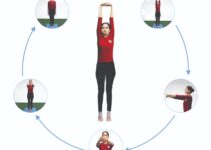What does mountain pose (Tadasana) mean?
Mountain pose or tadasana (tah-DAHS-uh-nuh) is the starting yoga pose to start a yoga session. The name itself suggests that one has to feel strong and tall while practising the mountain pose. It is also known as the palm tree pose because of its straight and elongated alignment. Mountain pose is one of the important standing yoga of Shankhaprakshalana, which systematically opens the various intestinal valves between the stomach and the bowels during this process and cleanses the gut from toxins and impurities.

How to do mountain pose (Tadasana) instructions
Technique: If you want to get the maximum benefits of this yoga pose, it is advisable to practice tadasana properly.
- Stand erect with your feet about 15 cm apart.
- Interlock the fingers of both hands.
- Hold your straight arms directly above your head facing the palms upwards.
- Inhale, stretch your whole body upwards as far as possible.
- Now, come on the toes and feel the stretching from toes to fingers.
- Maintain the pose as long as possible (initially 30 seconds).
- Exhale come to the original position.
- This is the one round. Do 2-3 rounds.
Mountain pose breathing and awareness
Breathe in deeply as you raise the body. Do deep breathing while maintaining the pose. Breathe out as you come to the original position. While holding the pose, it is better to fix a particular point to attain stability.
Number of rounds
For shankhaprakshalana and lagoon, Standing shankhaprakshalana does eight rounds. Otherwise, for general health purposes, you can practice as many games as you wish. Tadasana should be done after Sirshasana (the headstand pose) as a counterpoise.
8 benefits of mountain pose
Standing yoga has many essential benefits from toes to fingers if one practices it according to the above instructions.
- Height increase: The mountain pose in yoga gives desirable stretch from toes to fingers. That’s why it is considered one of the best yoga poses to increase height up to the age of 15-20 years.
- Nerves health: The entire body’s nerves and muscles get suitable stretching. Thus, practising it helps eliminate numbness, weakness, and neurological problems.
- Fat reduction and weight loss: Practising it regularly and maintaining the same for a certain period helps to burn extra fat and also activates body metabolism, thus ensuring more burning of fat from toes to fingers and giving the body a slimmer look.
- Treats sciatica: Since it is stretching yoga, it may relieve sciatic patients. However, it is recommended that such patients should practice it in the presence of a yoga therapist.
- Strengthens knees and ankles: Nowadays, pain in the knees and ankles is quite joint, along with the case of weak leg muscles. The pose helps to strengthen the leg muscles and overcome knee & ankle pain. It is also suitable for the buttocks, lower abdomen, shoulders, and neck.
- Improves concentration: It improves concentration, balance, and alertness. If you practice it correctly, you can extract more advantages from other yoga poses.
- Low back pain: It is beneficial in case of low lumbar spine pain. The yoga pose gives appropriate stretching to the entire spinal region. Therefore, it is also effective in combating the pain of the spine and associated muscles.
- Art of walking: Dr B K S Iyengar, the king of yogasana, said that walking and standing can only be attained if one practices tadasana technically.
Precautions of mountain pose
Though yoga shows the most minor side effects, caution and contradictions are related.
- Pregnancy: Women during pregnancy should skip performing this yoga pose.
- Varicose vein: The patient with the varicose vein should avoid it.
- Dizziness: During dizziness, skip it.
- Knee pain: Don’t stretch beyond your capacity as it may lead to knee jerk.
- Headache: If somebody is having a headache, skip to maintain it for a long duration.
- Insomnia
- Low blood pressure
Beginner’s tip
Initially, it is difficult to maintain the pose on the toes by raising the heels. You can perform it by keeping your heels on the surface. One also feels imbalance by keeping the feet together. In such a case, have a certain distance between the legs and gradually start minimising it. Beginners should practice the pose standing against the wall. The beginners shouldn’t maintain the posture for a more extended period. It will come after certain practices and in achieving some balance. To maintain balance, it is also advisable to keep your gaze fixed on a certain point.
Facts and tips
- Mountain pose is the fundamental asana for all the standing yoga poses.
- Alignment and muscle movement are essential as these are applied while practising the other yoga poses, especially the standing one.
- In Iyengar yoga school, the pose is performed by raising the hands over the head or keeping them at the sides of the legs.
- In Vinyasa yoga it is performed while coming on toes.
- In Ashtanga, yoga is the beginning and ending yoga pose of Surya Namaskar.
Modifications & variations
If you feel the above instructions are complex, try the modified and simpler version. Simply standing erect and keeping your arms beside your thighs is also a form of mountain pose. Try to keep the least distance between your legs. If you have knee and ankle problems, you don’t need to do more stretches in these areas.
Muscles and joint actions
The lumbar, thoracic, and cervical curves are experiencing extension. The knee joints are extended, the elbow joints are opened, and the forearms are pronated. The arches of the feet are lifted and connect with the upward-lifting action in the pelvic floor, the lower abdomen, the rib cage, the cervical spine, and the top of the head. The shoulder blades are dropped onto the support of the rib cage and connect with the downward release of the tailbone and the grounding of the three points of contact between each foot and the floor.






